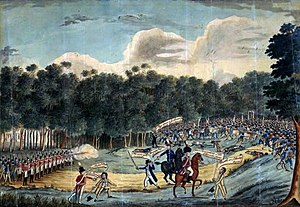Castle Hill Rebellion
| Castle Hill Rebellion | |||||||
|---|---|---|---|---|---|---|---|
 An 1804 watercolour depicting the rebellion and hangings |
|||||||
|
|||||||
| Belligerents | |||||||
| Convict insurgents |
|
||||||
| Commanders and leaders | |||||||
| Phillip Cunningham William Johnston |
George Johnston | ||||||
| Strength | |||||||
| 233 |
Total: 97
|
||||||
| Casualties and losses | |||||||
| 15 dead 9 executed 23 exiled |
None | ||||||
Total: 97
The Castle Hill Rebellion of 1804 was a rebellion by convicts against colonial authority in the Castle Hill area of the British colony of New South Wales. The rebellion culminated in a battle fought between convicts and the colonial forces of Australia on 5 March 1804 at Rouse Hill, dubbed the Second Battle of Vinegar Hill after the first Battle of Vinegar Hill which had taken place in 1798 in Ireland. It was the first and only major convict uprising in Australian history suppressed under martial law.
On 4 March 1804, according to the official accounts 233 convicts led by Philip Cunningham (a veteran of the Irish Rebellion of 1798, as well as mutiny on the convict transport ship Anne) escaped from a prison farm intent on "capturing ships to sail to Ireland". In response, martial law was quickly declared in the Colony of New South Wales. The mostly Irish rebels, having gathered reinforcements, were hunted by the colonial forces until they were sequestered on 5 March 1804 on a hillock nicknamed Vinegar Hill. Under a flag of truce, Cunningham was arrested and troops charged and the rebellion was crushed by a raid. Nine of the rebel leaders were executed and hundreds were punished before martial law was finally revoked a week after the battle.
Many convicts in the Castle Hill area had been involved in the 1798 rebellions in Ireland and subsequently transported as exiles-without-trial to the Colony of New South Wales from late 1799. Phillip Cunningham, a veteran of the 1798 rebellion, and William Johnston, another Irish convict at Castle Hill, planned an uprising in which over 685 convicts at Castle Hill intended to meet with nearly 1,100 convicts from the Hawkesbury River area, rally at Constitution Hill, and march on Parramatta and then Sydney (Port Jackson) itself. According to Helen Mackay, their goal was to establish Irish rule in the colony and obtain ships for those that wanted to return to Ireland to help revive the failed Irish Rebellion of 1803.
...
Wikipedia
